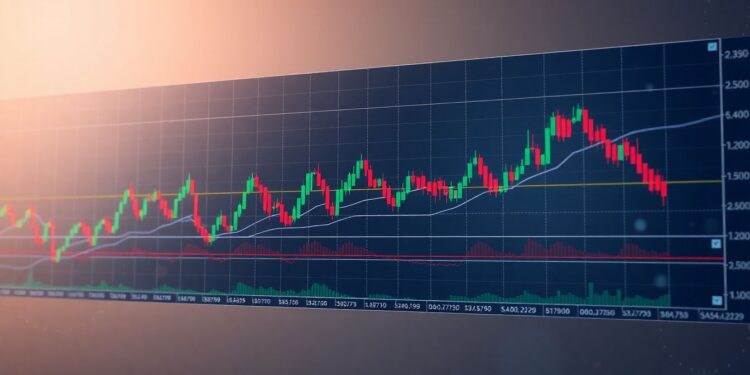Diving into the vibrant realm of Forex trading can be thrilling yet intimidating. With constantly shifting currency values, traders face a landscape of both opportunities and potential pitfalls. Among the array of tools available to traders, the moving average stands out as particularly valuable. This indicator aids in trend identification and helps traders make well-informed decisions.
The Appeal and Hazards of Forex Trading
The Forex market is known for its lucrative opportunities, but it’s not without its share of risks. Many traders find themselves bewildered by the rapid changes in the market. So, learning to read and interpret market signals is crucial for achieving success.
Tapping into Predictive Insights with Moving Averages
Moving averages are instrumental in smoothing out price action. They help traders recognize trends over different time frames by minimizing the noise created by volatile price swings, thereby enabling more strategic decision-making.
What You’ll Explore Here
In this piece, you’ll delve into:
- Different kinds of moving averages
- How to read moving average crossovers
- Leveraging moving averages alongside other indicators
- Tips on refining your moving average approach
- The significance of backtesting and continuous improvement
Understanding Moving Averages: Types and Their Calculations
For traders, understanding the subtleties of moving averages is a basic skill. Let’s explore the key types you’ll encounter.
Simple Moving Average (SMA): The Essentials
The Simple Moving Average (SMA) represents the mean price over a chosen number of periods. For instance, a 10-day SMA takes the closing prices from the past ten days and averages them, providing a view of the trend that smooths out daily fluctuations.
Exponential Moving Average (EMA): A Closer Look
Unlike the SMA, the Exponential Moving Average (EMA) puts more emphasis on recent prices, thereby responding more swiftly to price changes. This characteristic makes it particularly useful for traders seeking short-term signals.
Weighted Moving Average (WMA): Fine-Tuning Your Strategy
The Weighted Moving Average (WMA) offers a flexible approach by assigning differing weights to prices, often highlighting more recent data. This form of average can be useful for traders aiming to focus on current trends without dismissing historical data.
Interpreting Moving Average Crossovers for Trading Signals
Crossovers between different moving averages can be promising indicators of trading opportunities.
Spotting Golden Crosses: Bullish Signals
A Golden Cross happens when a short-term moving average rises above a long-term moving average, often hinting at the start of a bullish phase. This event can signal traders to consider buying in anticipation of upward momentum.
Identifying Death Crosses: Bearish Signals
Conversely, a Death Cross occurs when a short-term moving average falls below a long-term moving average, potentially indicating a bearish turn. Traders might choose to sell to minimize losses in such scenarios.
Guarding Against False Signals: Understanding Context
While crossovers can serve as useful indicators, they sometimes lead to false signals. It’s important to consider the broader market context to make valid trading decisions.
Enhancing Your Strategy with Additional Indicators
Harnessing the power of moving averages along with other indicators can significantly bolster trading strategies.
Combining with RSI for Stronger Signals
The Relative Strength Index (RSI) measures market momentum, and pairing it with moving averages can bolster signal verification. If both the RSI and moving averages suggest a buying opportunity, the case is strengthened.
Refining Entry and Exit with MACD
The Moving Average Convergence Divergence (MACD) indicator highlights the relationship between two EMAs, which can help refine entry and exit decisions when used in conjunction with moving averages.
Leveraging MACD for Momentum Shifts
Observing how moving averages converge and diverge with MACD allows traders to identify shifts in market momentum and anticipate changes in trends.
Optimizing Your Moving Average Approach
A robust strategy is fundamental to effectively utilizing moving averages.
Choosing the Right Period Length
Selecting the appropriate period for your moving average is key. Shorter periods may offer quick signals but can be noisy, while longer periods provide smoother trends but may be slower to react to new information.
Employing Multiple Moving Averages
Using more than one moving average can offer diverse insights. For example, a combination of a short-term EMA with a long-term SMA can aid in capturing market shifts more comprehensively.
Incorporating Risk Management
Always integrate risk management into your strategy to balance potential losses with gains. Position sizing is essential for safeguarding your trades.
Backtesting and Adjusting Your Strategy
To validate your strategy, backtesting it against historical data is vital.
Analyzing Historical Data
Reviewing past performance offers insights into the efficacy of your moving average approach, allowing you to refine what works and discard what doesn’t.
Engaging in Paper Trading
Before risking actual capital, paper trading offers a risk-free environment for practice. It’s an excellent way to tweak your strategies involving moving averages without financial exposure.
Adaptation and Continuous Improvement
As the market is always changing, regularly revisiting and adjusting your strategy is crucial for sustained success.
Conclusion: Achieving Mastery in Moving Average Forex Trading
Actionable Takeaways
- Grasp various types of moving averages
- Monitor crossovers for possible trading signals
- Combine indicators for enhanced confirmation
- Practice risk management and keep evolving your strategies
Continuous Learning and Application
Practicing and refining moving averages takes time. Implement the strategies explored here and enhance them with experience.
Expanding Your Knowledge Base
Keep growing by immersing yourself in Forex trading courses, engaging with books, webinars, and participating in online communities where valuable insights abound.
Take proactive steps in your Forex trading journey today by leveraging the power of moving averages. Your pathway to making smarter trading decisions begins now!


















